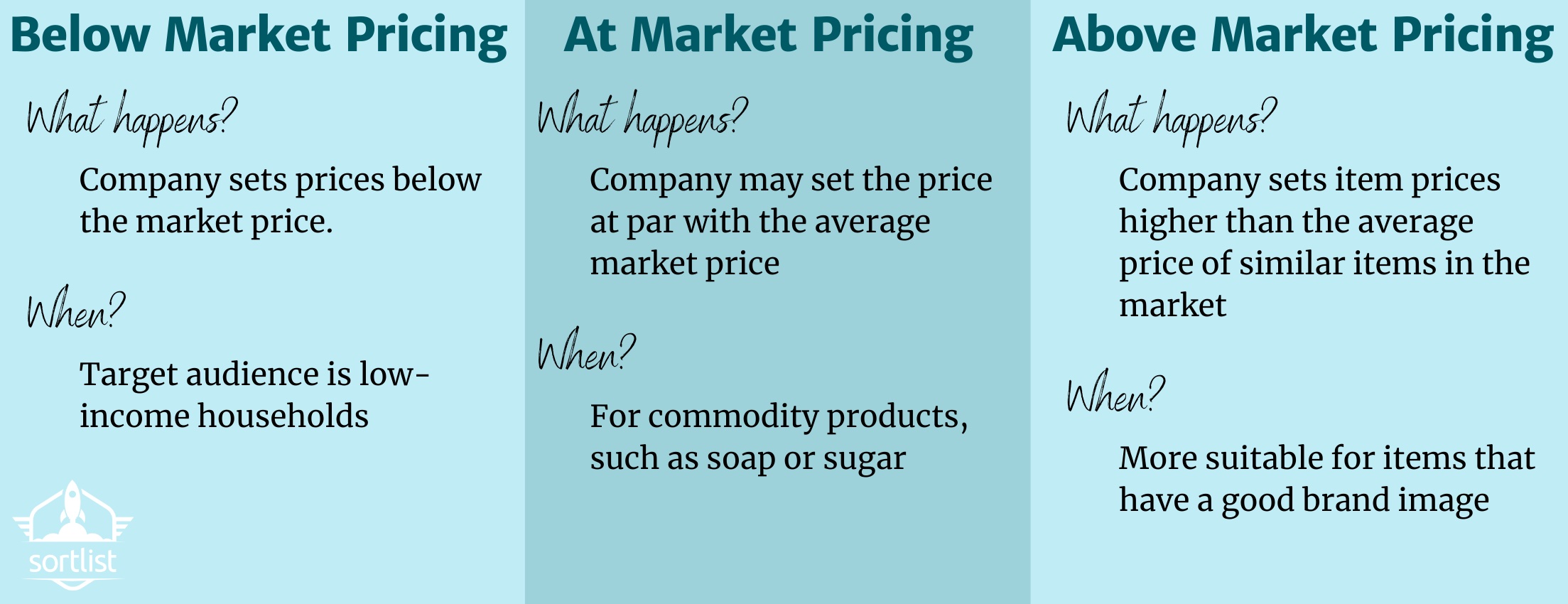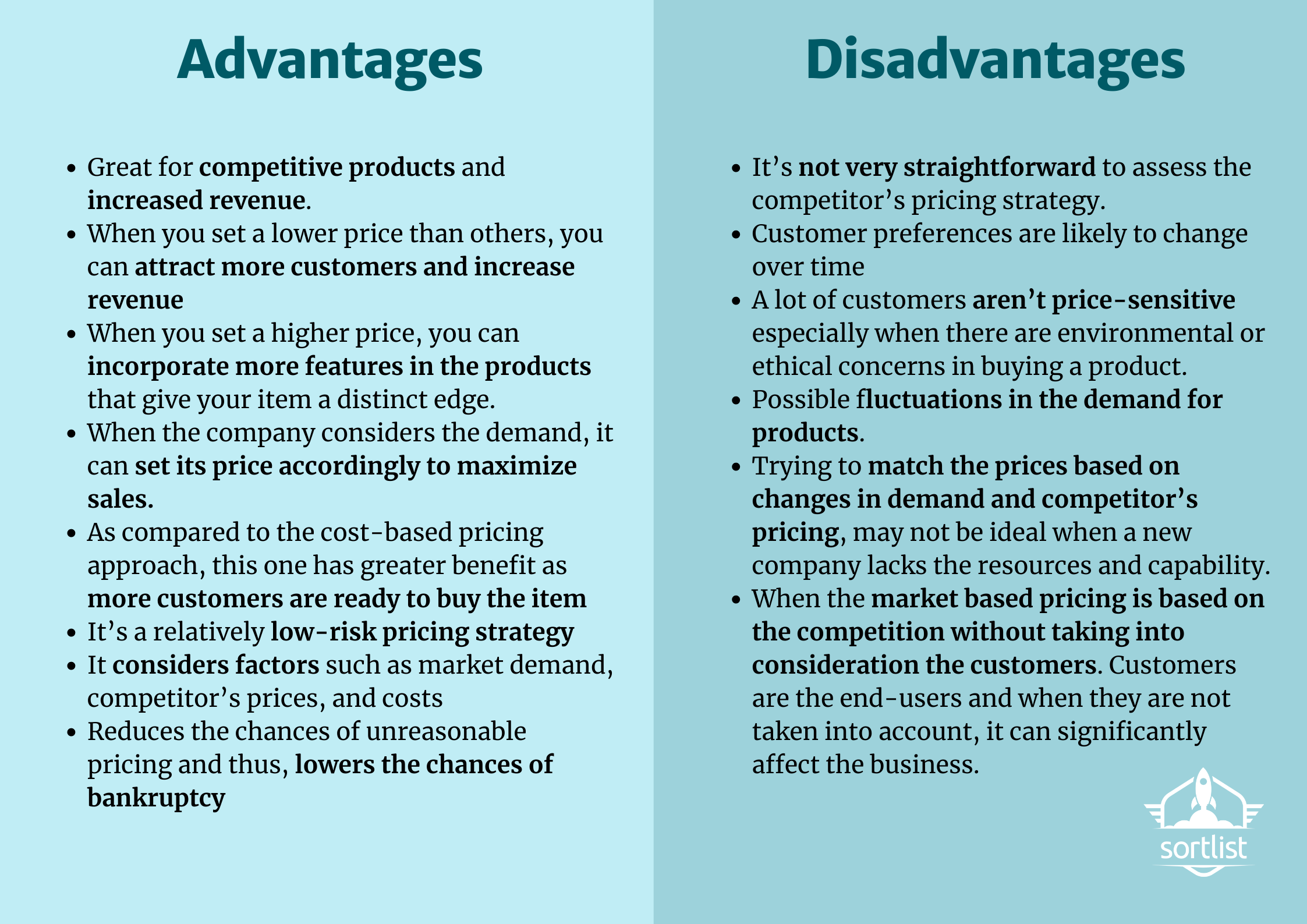
Simple Guide to Market Based Pricing
Last update: 14 February 2024 at 04:29 pm
When you own a business, setting the prices for your itemsand services is often one of the most challenging tasks. If you set the prices too high, your sales could decline. If you set them low, then you may miss out on sizeable revenue. The skill is in knowing how to get the market based pricing right.
In this article, we’re going to discuss the market based pricing strategy to arrive at an optimum price for your product.
Key Takeaways
- Understanding Market-Based Pricing:
- Pricing is based on market demand and supply dynamics.
- Reflects current market prices for similar products.
- Factors Influencing Pricing:
- Considerations include product demand, life cycle, and competitor pricing.
- Target market, demand trends, and resources also impact pricing decisions.
- Types of Market-Based Pricing:
- Strategies like price skimming, penetration pricing, and premium pricing.
- Also includes promotional pricing, loss leader pricing, and psychological pricing.
- Pros and Cons:
- Offers flexibility and responsiveness to market changes.
- Requires careful consideration of various factors to avoid pitfalls and maximise profitability.
What is Market Based Pricing?
To answer the question “what is market based pricing” simply, it is the setting of the price of a product based on the marked demand and supply.
In a market based pricing strategy, the price of the product is based on the current market price for similar products in the market.
It could also allow the business to set the price higher than other similar products while it’s new in the market, and gradually align at a later point to remain in the competition. It’s also called market oriented pricing.
Product Demand
You can also gauge the market demand. For instance, if the demand is high, you can increase the price. When the demand is low, you can offer discounts or incentives to encourage customers into buying the item.
This is a common case in electronics. Also, when a product is rare, people are willing to pay higher prices; but when many people have it, the charm of buying it is gone and that’s when you can consider reducing the price.
Life Cycle
The life cycle market based pricing strategy can also be determined by the product life cycle. When the product is introduced, it can have the price set according to the competitors’ products. But later on, the price needs to be readjusted as new competitors emerge, and also according to the demand.
You must always re-evaluate and analyze the pricing regularly, to keep a suitable price for your product.
Calculation
To calculate the market based price, you must:
add the cost of your product to the market factor price, and also add a premium if you think it’s the right idea
Types of Market Based Pricing

Market Based Pricing Methods
Price Skimming
In the pricing skimming market based pricing strategy, a company sets the price higher at the launch of the product. Gradually, when the sales increase, it brings down the price.
This is not a very common approach. This market based pricing strategy is more suitable for innovative products that are new to the masses. For example, at the beginning of computers and cellphones, various manufacturers adopted this method.
Penetration Pricing
It is the opposite of the above method. In penetration pricing, the company will first set a lower price for its item as compared to the competitors. When the sales increase and its market position becomes strong, it’ll increase the price. This method is more suitable for companies that are looking to build a customer base and market share.
Discriminatory Pricing
In this marked based pricing stategy, the company sets varied prices for different customers. Customers who have a higher reservation price will pay a higher amount.
Businesses that are seeking to make the most profits use this method. However, this is not a common practice as it can lead to reselling by customers at higher prices, and it’s also not good for the brand image.
Premium Pricing
Under this pricing strategy, a business can charge a higher price for superior quality products, and also, due to its brand image.
For example, Apple products are highly priced in comparison to their counterparts. To maintain their image, companies target quality-conscious or class-conscious customers. Those customers are into premium brands and also willing to adjust to price changes.
Promotional Pricing
A promotional pricing strategy ascertains a discounted price for the short-term to stimulate the demand for the product. There are various other ways to promote a product, such as price discounts, coupons, freebies, loyalty cards, etc.
Loss Leader Pricing
Under this pricing method, the firms usually set a lower price, below the average market cost. It’s more common among retailers. Its objective is to attract more customers to the store. To compensate for the losses made due to discounting, the retailers will entice the customers to buy expensive products from their store.
Another strategy is predatory pricing. In this method, the retailer is willing to incur more losses just to drive the competitors out of business. They can then enjoy a monopoly that will enable them to increase the prices later.
Psychological Pricing
Under this strategy, the firm sets prices impacting the customer psychology. For example, a company may sell its item at $2.99, which would be just a cent cheaper than other similar items of $3.00.
This may lead some customers into thinking that the former is cheaper than the latter. This method usually targets customers who aren’t that rational.
Factors Affecting Market Based Pricing
In this pricing model, the business takes into account various factors while determining the market based pricing value. This also includes the customer needs and their price sensitivity.
Target Market
Whether the target market is a mass-market or a differentiated one, it would require a different approach. Likewise, if the firm is targeting a niche market, the approach would change. The target market can be new or existing depending on the kind of product.
Demand Trends
The firm can adjust the price according to the demand. For example, if the demand is high, it can charge a high price; if it’s low, it can fix a lower price to attract more customers. Alternatively, during low demand, a company can offer discounts and promotional offers instead of adjusting the price.
Competitors’ Price
A firm can lower its price a bit if a competitor does the same. However, when all the players keep competing to lower the prices, it can lead to price wars.
Resources
Just fixing the price according to the competitor pricing strategy is not a good idea. The other company may have a strong market hold and have more resources to adjust its pricing. Therefore, blindly adjusting the prices based on competitor’s when you don’t have as many resources as them, can lead to losses.
Lifecycle of the Product
When a company introduces an item in the market, it sets a lower price. But as it attains a customer base and has a stronger market position, it can raise the prices a bit.
Price Elasticity of Demand
The company must also take into account how price-sensitive the customers are. When the demand is elastic, a 2% decrease in price can lead to a more than 2% increase in demand. When it’s an inelastic demand, a 2% price reduction can cause less than a 2% rise in demand.
Pros and Cons

Conclusion
Market based pricing is a commonly used approach to determine the prices of the products. It can lead to good results if all the factors are considered diligently.
But a company must also take into account internal factors such as its resources, capabilities, vision, and ethical standards. Using this method, it must set the optimum price without draining its own resources, only then it will be effective in the long run.





